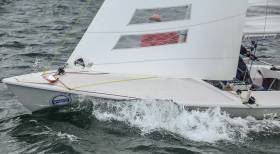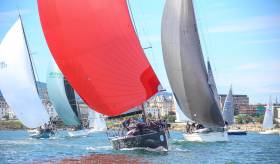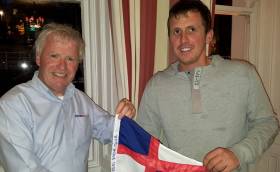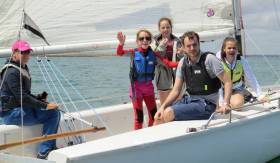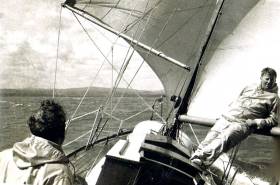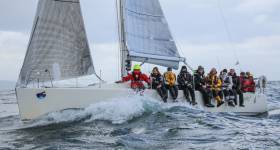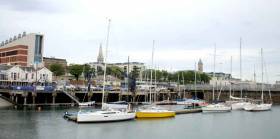Displaying items by tag: National Yacht Club
Large Turnout in Flying Fifteen DBSC Series Race
On a cloudy grey evening with stormy clouds hovering the Flying Fifteen fleet got more than they expected with strong force 4-5 winds from the west on Thursday evening. With no race last week, repaired DBSC Committee Boat Freebird was ready and waiting at the start line. Despite the peak holiday season a great turnout of 16 boats had an exciting evenings sail with Alan Green and Chris Doorly taking the gun in a close and exciting finish from Neil Colin & Margaret Casey.
The start with its pin end bias was hotly contested with Dumpleton and Green vying for a position to get the pin. Green popped out and after a while managed to cross the fleet on port as the fleet headed towards Harbour mark. It seemed that the hard work was done and he was in control of the fleet but it was not to last as those who headed in towards the shore got to the mark first, Neil Colin led the way from David Mulvin and Neil Coleman.
The wind really picked up on an exciting tight reach led by Colin, behind there were thrills and spills with several broaches! On towards Poldy the fleet were busy trying to avoid Ruffians. As they approached the mark Green got inside Coleman and on rounding the mark squezed inside David & Valerie Mulvin to move into second place on the beat. This is how it stayed for a while but the gap closed as we approached Bay mark and the chase was on down to East mark where Colin & Casey still held their lead. He headed inshore while Green headed toward the dark looming clouds towards the city. On tacking in towards the finish it was all about boat speed- what would happen as they converged adjacent the line? As the finish loomed closer it was Green that crossed clear of Colin to take the gun, a great finish to a great race set by Jack Roy and his team. It was still close behind with Alistair & Conor just pipping Coleman for third with McCambridge fifth.
The skies were grey but this didn’t deter the keen young sailors who participated in the Davy National Yacht Club Junior Regatta last Wednesday writes Frieda Ford. With over 110 participants there was a buzz at the National.
Representatives from all Dun Laoghaire's clubs registered in the afternoon before the event and received a super goody bag containing plenty of treats including a great Davy SPF balm and a fidget spinner.
After a comprehensive briefing both fleets commenced launching - the Harbour Fleet took to the water at 10:45 am and the Main Fleet at 11:15 am. Three races were completed by both fleets in gusty winds.
Presentations took place late in the afternoon before the other social part of the evening - the junior disco. While parents socialised on the balcony the junior sailors enjoyed a fun evening that was supervised by the fantastic NYC instructors.
With the success of Volvo Dun Laoghaire Regatta 2017 now universally acknowledged in highlighting the developing role of Dun Laoghaire Harbour as a major waterborne recreational centre, it is timely to remember the vital contribution made to the contemporary scene by Dun Laoghaire Marina. Since 2001, it has been quietly yet efficiently getting on with the business of providing the modern facilities which have brought the staging of international big-fleet and keelboat events comfortably within the Harbour’s annual programme. W M Nixon takes up the story
It is a historical fact that when the new Harbour was being planned in Dun Laoghaire 200 years ago, very little if any provision was made to include shore-side facilities in the overall project. The magnificent new granite structure was envisaged purely as an Asylum Harbour to shelter ships waiting to enter or leave the port of Dublin, which in those days was restricted by a shallow entrance unusable at low tide.
Far from providing those on board such vessels with convenient contact with the nearby and initially sparsely-inhabited shore, it was a matter of harbour planning policy that, ideally, there’d be no such contact whatever. Yet even at an early stage of the works, it was increasingly evident that it was potentially a magnificent amenity that would lend itself well to the expanding popular association of the seaside with leisure of all kinds, whether it be simply enjoying the bracing sea air, or interacting more dynamically with nautical activity through boat and water sports.
 The installation of Dun Laoghaire Marina was another stage in providing convenient and safe shoreside access for a harbour in which such access was originally very limited. Photo: Tim Wall
The installation of Dun Laoghaire Marina was another stage in providing convenient and safe shoreside access for a harbour in which such access was originally very limited. Photo: Tim Wall
So although the harbour was not considered finished until 1859, and to some extent has always continued as Work in Progress ever since, by 1859 a fashionable seaside town had already developed beside it, with much emphasis on harbour and sea-related events.
The recent across-the-board success of the four-day Volvo Dun Laoghaire Regatta 2017, with a diverse fleet of 475 boats taking part, was a reminder of how long this supposedly utilitarian harbour has been central to the seaborn leisure activities of the people of Dublin, and particularly those who live in the immediate south county area in what is now Dun Laoghaire-Rathdown.
In addition to the many sailing championships included in the impressive programme for 35 classes, the Regatta celebrated the Bicentenary of the beginning of work on the construction of the harbour in 1817, with 2017’s sailing programme seeing innovative Bicentenary events and special trophies. And of these trophies, arguably the most interesting were framed copies of an engraving showing the first recorded regatta at the harbour, which was staged in 1828, barely eleven year after the massive harbour works were started.
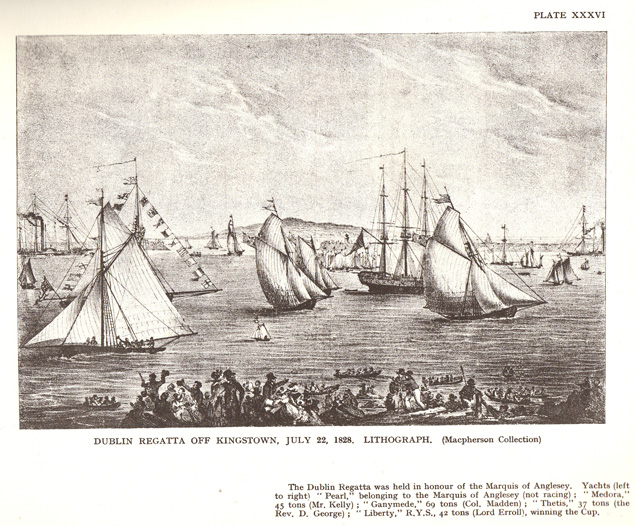 The first Regatta of 1828. Copies of this engraving were awarded as prizes in the Volvo Dun Laoghaire Bicentenary Regatta 2017.
The first Regatta of 1828. Copies of this engraving were awarded as prizes in the Volvo Dun Laoghaire Bicentenary Regatta 2017.
There had been such a demand to utilise the recreational potential of the harbour that many noted racing yachts of the day were prepared to undertake their sailing competition from a harbour which was still a building site, and with very limited shoreside amenities at that. This was to become a theme of the Dun Laoghaire story. In fact, by the time the harbour had achieved the broad outline of its finished form in 1859, the waterfront had acquired the first clubhouse of what became the Royal St George Yacht Club as long ago as 1838, while the Royal Irish Yacht Club, having briefly thrived without a shore-base clubhouse at its foundation in 1831, was revived in 1846 and by 1851 had its magnificent clubhouse, the world’s oldest complete purpose-designed yacht club building, in place on the waterfront.
This process of waterfront development continued with the Edward Yacht Club – now the National Yacht Club – completing the trio of substantial yacht club buildings on the main harbour in 1870, while in modern times it was just over fifty years ago that the Dun Laoghaire Motor Yacht Club came into being on the quayside in the inner Coal Harbour.
These four clubhouses, while diverse in character and style, all share one characteristic. They are miracles of the skillful utilisation of very limited space. For although the town may have grown rapidly because of the existence of the harbour, such was the demand for building space on the fashionable waterfront, and the need for the provision of harbourside roads and a through railway, that the buildings actually serving the needs of ships, seafaring and recreational sailing, were crowded in along a very narrow waterfront strip.
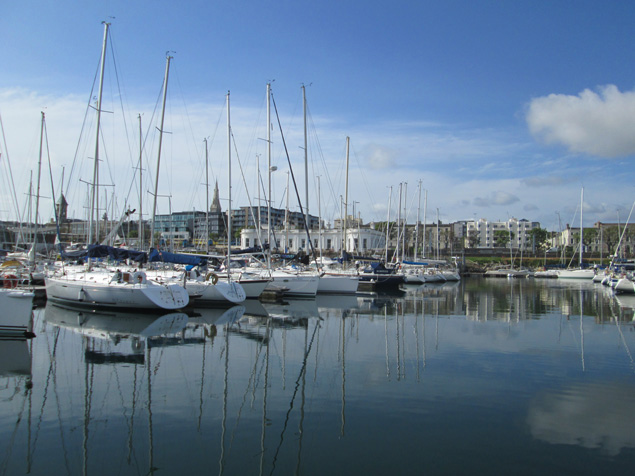 The Royal Irish YC clubhouse of 1851 as seen from the modern marina. This historic clubhouse was built and functioning eight years before the harbour was declared complete.Yet despite the severe limitations of the space available to them, the various waterfront organisations have continued to function and indeed thrive in their activities. So much so, in fact, that it could reasonably be claimed that the outstanding success of the Volvo Dun Laoghaire Regatta 2017, and particularly its Kingstown 200 celebratory highlight, has been a game-changer in reinforcing perceptions of the harbour’s potential.
The Royal Irish YC clubhouse of 1851 as seen from the modern marina. This historic clubhouse was built and functioning eight years before the harbour was declared complete.Yet despite the severe limitations of the space available to them, the various waterfront organisations have continued to function and indeed thrive in their activities. So much so, in fact, that it could reasonably be claimed that the outstanding success of the Volvo Dun Laoghaire Regatta 2017, and particularly its Kingstown 200 celebratory highlight, has been a game-changer in reinforcing perceptions of the harbour’s potential.
There is now definitely a viable future for Dun Laoghaire as a recreational leisure and sporting centre in the broadest sense, whether it be for sailing, rowing, other water sports, or simply enjoying the bracing sea air by walking the splendid main piers which - still largely in their superbly-built original form - have for so long been such an elegant aspect of Dublin Bay that many of us find ourselves thinking of them as natural features.
However, in celebrating the great events of the Regatta of July 6th to 9th 2017, there is one important element in the modern Dun Laoghaire’s provision of facilities which is sometimes overlooked. Perhaps it’s because it simply gets on with what it was planned to do in a professional and unshowy style, for whatever reason these days we tend to take the existence of Dun Laoghaire Marina for granted.
But the harbour’s contemporary year-round sailing programme, and its confident ability to provide totally secure berthing for up to 820 boats of all sizes up to superyachts and record-breaking giant multihulls, is all because of the quiet existence within it of the largest marina in Ireland, which provides hundreds of completely sheltered and fully-serviced pontoon berths in an area whicb formerly only had space for 70 swinging moorings, moorings which were by no means completely sheltered in all conditions.
And yet this facility, still seen as new, is very much of the Harbour in that, of all the diverse maritime facilities on Dun Laoghaire waterfront, it is the Marina which is most water-based. Its footprint ashore is relatively minuscule. It has been allowed just enough space on land for the administrative/reception and services building. But apart from that, its own wide-ranging facilities are completely afloat, as the travel-hoist which serves the fleet is on a different area of Harbour Company land. Although that is leased to the Marina, it is in its turn sub-contracted out to be operated by MGM Boats Ltd, the multi-functional marine trade company which includes boatyard operations within its many areas of expertise.
The long-established yacht clubs may have expanded their originally small sites to became more substantial spaces. But as the aerial photos tellingly reveal, the marina manages to provide its core activities and facilities with a minimal toehold ashore. Yet those core activities and facilities afloat are central to the sailing and boating success of modern Dun Laoghaire, and with the Marina now 16 years old – it officially opened on St Patrick’s Day 2001 – it is time and more to acknowledge its quiet yet very significant contribution.
 While the Marina is a significant presence afloat, its office footprint on the waterfront is very small, slotted in between the extended hard standing of the Royal Irish YC (right) and the marshalling yards for the former cross-channel ferry service (left).
While the Marina is a significant presence afloat, its office footprint on the waterfront is very small, slotted in between the extended hard standing of the Royal Irish YC (right) and the marshalling yards for the former cross-channel ferry service (left).
That significance can best be put into perspective by putting our minds back to 1986. While Dun Laoghaire Harbour may have been a pioneering facility in the way it developed between 1817 and 1859, by the final decades of the 20th Century it was clearly in need of modernisation, with the urgent need for the addition of properly sheltered pontoon berthing to keep it in line with facilities elsewhere - not just abroad, but also in Ireland, where places like Crosshaven, Howth and Bangor were beginning to enjoy full marina availability.
While Dun Laoghaire sailing enthusiasts of the calibre of Olympic helmsman Jimmy Mooney had been advocating a marina for years in order to offset their harbour’s seriously exposed condition in northeast gales, there was understandable resistance among those who saw the harbour as a beautiful creation in its total and original concept, even if shoreside areas of it were disfigured by the facilities required by ferries operating the cross-channel route to Holyhead.
But then in August 1986, Hurricane Charley struck. Force 12-plus northeasterlies caused enormous damage along Ireland’s East Coast, with Dun Laoghaire experiencing the perfect storm. The harbour was like a giant washing machine, and waterfront and fleet damage and loss was widespread, with classic yachts such as the Dublin Bay 24s and the Dublin Bay 21s – for so long an adornment of the harbour – suffering to such an extent that in effect it marked the end of the Dublin Bay 21s as an active class.
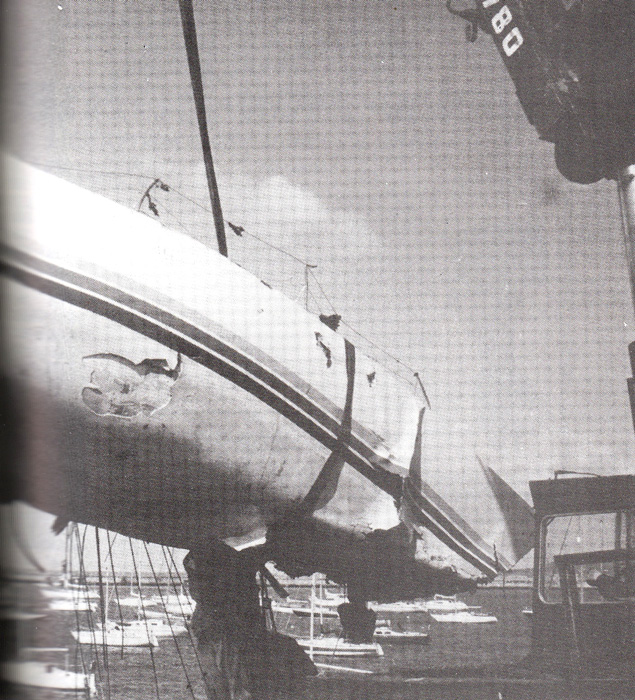 The destruction wrought by the northeast storms of Hurricane Charley in August 1986 was widespread on Ireland’s East Coast, and the Dun Laoghaire fleet saw boats of all sizes wrecked through broken moorings. This is the remains of the Sisk brother’s X40 Alliance being brought ashore – the caption tells us “this was the less-damaged side”. Photo: David O’Brien/Afloat Magazine
The destruction wrought by the northeast storms of Hurricane Charley in August 1986 was widespread on Ireland’s East Coast, and the Dun Laoghaire fleet saw boats of all sizes wrecked through broken moorings. This is the remains of the Sisk brother’s X40 Alliance being brought ashore – the caption tells us “this was the less-damaged side”. Photo: David O’Brien/Afloat Magazine
After August 1986, the provision of a proper in-harbour marina became a question of “when” rather than “if”. Knowing how long contentious planning matters can take to be resolved in Ireland, it’s actually remarkable that a new marina, located within in-harbour breakwaters of a high standard to match the quality of the main piers, was in being just 15 years and seven months after the balance was tipped in its favour by Hurricane Charley.
Of course there were many other factors involved in the successful implementation of this radical new development, and some people had been working in support of it for many years. As the new and superbly-sheltered amenity became increasingly accepted, supported and used, one of its longterm advocates famously remarked that it had taken 25 years for Dun Laoghaire Marina to become an overnight success.
It may seem strange now that the new marina seemed so strange then, but we have to remember that the Dun Laoghaire Harbour into which it was inserted 16 years ago was a very different place. It was still an active ferry port, with a fully professional harbour staff in charge of the overall administration. But while the clubs were significant employers of professional staff for their facilities afloat and ashore, those employees were in turn answerable to the voluntary democratically-elected officers of each club.
With the marina, however, everything was on a much larger scale. It had to be seen as a commercial proposition, run as a business by competent professionals who were answerable to a management company which in turn was answerable to its shareholders.
And of course the services of the marina were available to any competent boat-owner who was prepared to pay for its excellent facilities. Instead of mainly relying on a club ferry service to get you to and from your boat, you could now step on board as and when you wished. And while the marina management tried to cluster classes and groups of fellow club members in its berthing allocations if possible, it was by no means a requirement, and the relatively closed sailing community had to open its mind and attitudes to newcomers and strangers.
 Hal Bleakley became the first General Manager of the new Dun Laoghaire Marina in 2001. Photo: courtesy Dun Laoghaire Marina
Hal Bleakley became the first General Manager of the new Dun Laoghaire Marina in 2001. Photo: courtesy Dun Laoghaire Marina
It could have been impersonal, but it wasn’t, thanks to the extremely sensible selection by the owners of the marina’s General Managers. There have only been two since 2001, Hal Bleakley who was himself of the Dun Laoghaire sailing community through and through, and Paal Janson, who succeeded him in 2011 after working with him on the small but dedicated marina team for years.
Hal Bleakley was a consummate amateur sailor and race officer whose professional life had been as Maintenance Director for Aer Lingus. It was the perfect CV for a challenging job which simply hadn’t existed in the complicated Dun Laoghaire matrix before.
As for Paal Janson, as you’ll guess he’s of Norwegian descent, but he is very much of Ireland even if there’s a photo of a Janson ancestor’s sailing boat racing at Bergen in the 1920s on the walls of his office, which is more than just an office, it’s a control centre as well, as he can oversee the entire busy marina from it.
 A man and his marina – Paal Janson has been General Manager of Dun Laoghaire Marina since 2011, and has seen it receive new awards and recognition. Photo: David O’Brien/Afloat.ie
A man and his marina – Paal Janson has been General Manager of Dun Laoghaire Marina since 2011, and has seen it receive new awards and recognition. Photo: David O’Brien/Afloat.ie
Like Hal Bleakley, Paal Janson (he tends to be called Paul) brings a very useful professional background, as he was formerly a deck officer in the International Merchant Marine, accustomed to dealing calmly with all sorts of sea-related problems, and in ensuring that things run smoothly without fuss.
With a staff of ten – three for the office and the others working throughout the extensive marina itself – he has been assiduous in keeping Dun Laoghaire marina in its position of high standing among international-level yacht harbours, which is such that it became the first coastal marina among the 23 in the Republic of Ireland to achieve the coveted Five Anchor Award. This was awarded originally in 2008, but more importantly it has been retained ever since, successfully coming through rigorous annual inspections.
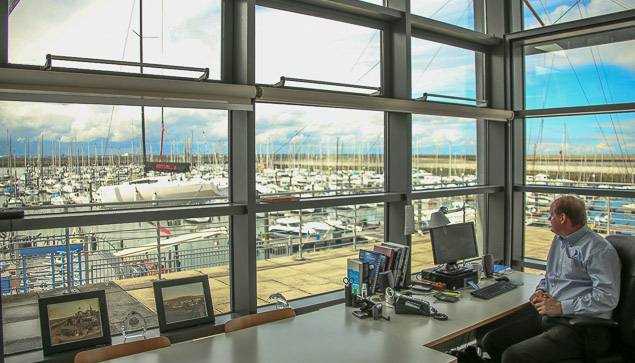 The control centre – the General Manager’s office provides the ultimate view. Photo: David O’Brien/Afloat.ie
The control centre – the General Manager’s office provides the ultimate view. Photo: David O’Brien/Afloat.ie
In retaining the Five Gold Anchors, you are at least dealing with people who understand what a successful marina is trying to do. But not everyone necessarily does so. Thus a challenge which Paal Janson has successfully overcome is getting recognition from Failte Ireland that his marina is a significant player in modern Ireland’s tourism boom.
It has to be said that at times Failte Ireland moves in mysterious ways. You would have though that having a facility of the calibre of Dun Laoghaire Marina on the doorstep of a capital city would have been regarded immediately and enthusiastically as deserving some sort of official accreditation. But it took a while to persuade the powers-that-be a couple of years ago that it was worthy of Failte Ireland’s “Welcome Standard” of accreditation, and in fact 2016 was the first full year in which they enjoyed this official recognition, the first marina in Ireland to do so.
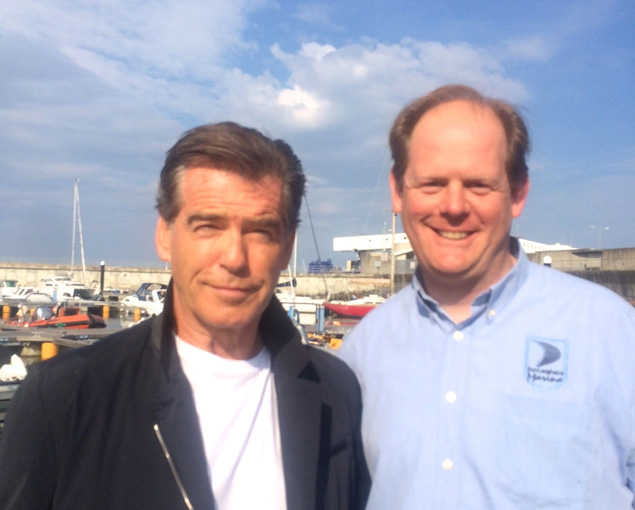 When you’re running a top marina, all sorts of people come to call…
When you’re running a top marina, all sorts of people come to call…
From a tourism point of view, the presence of the marina can be beneficial in several ways. Apart from its functional value, it is a symbol of peace and prosperity. The very idea of “picturesque poverty” is now rightly regarded as a Victorian obscenity, but the notion of a cruising yacht going harmlessly on her way with her crew enjoying the experience is an extremely reassuring concept in an increasingly disturbed world.
The quiet hint of a comfortable level of prosperity cannot be over-estimated. When Ireland plunged off the economic cliff with the collapse of the Celtic Tiger, tourism numbers plunged. After all, who wants to go on holiday in a country in the depressed grip of an economic recession? But as the green shoots of recovery strengthen, the mood lightens, and people increasingly want to be part of it, so the fact of more visiting boats is in itself an encouragement for further growth.
Currently, it looks as though there’ll be upwards of 600 visiting yachts of all shapes and sizes from more than 20 different countries using Dun Laoghaire Marina this year, including at least half a dozen superyachts. On average, the ordinary cruising boat stays 3 to 4 days, and while their crews find the draw of Dublin’s world-standard tourist attractions a significant appeal, they enjoy returning by DART to a fresh and lively port where the evening sailing programme may be getting under way.
Another particular attraction is that an Airport bus route has a stop within a very short distance ashore. Dun Laoghaire rates highly for its convenience for long-distance crew changes. When you’ve settled into the ways of the sea but realize that dealing with shore realities will shortly be on the agenda, it’s encouraging to know there’s a port ahead where not only can they assist with that, but they can provide helpful printed mini-pocket guides to get the best of Dun Laoghaire while you’re waiting there for your new crew to arrive.
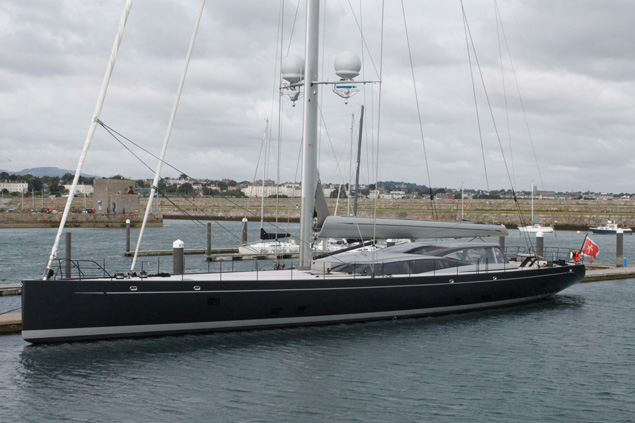 Big boats need grown-up facilities – Dun Laoghaire Marina can provide them
Big boats need grown-up facilities – Dun Laoghaire Marina can provide them
Of course, while the Marina makes a high priority out of being visitor-helpful, it also goes out of its way to be user-friendly for its own berth-holders, and one particular service is relied on by visitors and locals alike. Dun Laoghaire Marina maintains a list of accredited marine specialists and service providers in the immediate neighbourhood, and the welcome feeling of reassurance that such a list is there – even if you don’t have to avail of it – is something which adds to the attraction of the package, while its inclusion in the town’s economic activity and local employment is of real significance as marine experts in all trades from electronics through engineering and boat repair to sail-making are kept busy.
In all, it provides a welcome sense of reaching a centre of excellence when you enter the marina. As visiting cruisers make their way into Dun Laoghaire through late afternoon and early evening, those watching ashore will share the warming experience of another mini-voyage successfully completed. Not that departures and arrivals are restricted to morning and evening. At the height of summer, the Marina sees signs of life 24/7 as boats come and go at all hours depending on their destination and the timing of a favourable tide.
As for those who are actually at home there, Paal Janson has analysed the figure to provide a useful database for anyone studying boat ownership and use. In terms of sail versus power, he reckons in the good times the ratio was 60% sail to 40% power, but there’s no doubt that in recession, there was more of a decline in powerboat ownership than with sailing boats. But as the good time roll again, some of the powerboats appearing are extremely impressive.
Within the sailing boat category, the division between racing and pure cruiser is about 50/50, despite the fact that Dublin Bay Sailing Club’s programme is so firmly embedded in the Dun Laoghaire psyche that you’ll get boats racing with the DBSC fleet on a Thursday night that wouldn’t at all be seen as racers of any kind elsewhere.
It is the range of users for which Dun Laoghaire Marina caters which underlines the breadth of the boat-minded community attracted to its convenient facilities. Since 2007, one of the fixtures of the Marina’s extensive “floating forecourt” has been a Personal Lift which facilitates the Irish Wheelchair Association in getting disabled sailors aboard boats adapted for their use.
 The Irish Wheelchair Association and Dun Laoghaire Marina have combined forces to provide a personal lift and convenient berthing for a specially modified RIB to take wheelchair users to sea, and it is a very frequently-used facility.
The Irish Wheelchair Association and Dun Laoghaire Marina have combined forces to provide a personal lift and convenient berthing for a specially modified RIB to take wheelchair users to sea, and it is a very frequently-used facility.
The fact that this frequently-used setup is in Dun Laoghaire is a reminder of the marina’s inbuilt location advantage over every other marina in Ireland. Dun Laoghaire is conveniently at the heart of one of the largest populations in Ireland, and that population s right beside the sea. So if providers of specialist services of any kind for the boat population seek to increase their activities, they have to remind themselves that ultimately it is the numbers game which will be the key factor in their success.
Thus if you’re going to building up a sailing school – whether inshore or offshore or both – then by being Dun Laoghaire-based, you’re providing your courses within easy reach of a lively, potentially affluent, and numerically large sector of the population.
So although the longest-established of all Dun Laoghaire schools, the Rumball family’s Irish National Sailing School – runs its dinghy courses from facilities within the Inner Harbour beside its HQ, for its most recent ventures into offshore training it uses the marina for berthing requirement. And for several years now the marina has been the base for Ronan O Siochru’s Irish Offshore Sailing, which specialises in this area to such good effect that one of its training yachts, the 37ft Desert Star, was overall winner of the 33-boat Sailing Schools division in the Rolex Fastnet Race 2015.
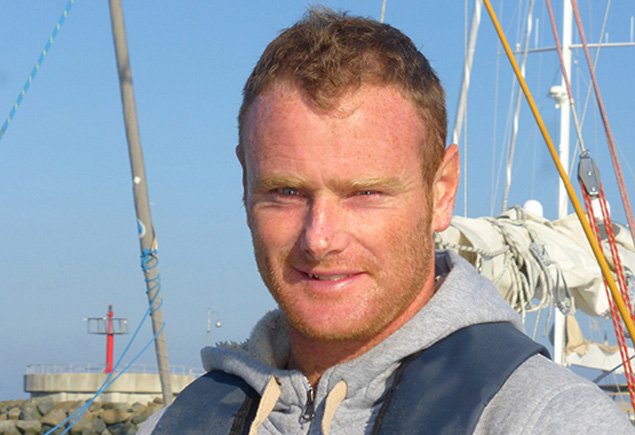 Ronan O Siochru of Irish Offshore Sailing, back in Dun Laoghaire Marineafter his class win in the Rolex Fastnet Race 2015. Photo W M Nixon
Ronan O Siochru of Irish Offshore Sailing, back in Dun Laoghaire Marineafter his class win in the Rolex Fastnet Race 2015. Photo W M Nixon
It was a matter of special pride for the Dun Laoghaire Marina staff that a boat which operated from their base should have achieved such international offshore acclaim, and since then standards have continued to rise, as the Irish National Sailing School are now also very much into the offshore game, with their J/109 lined up – like Desert Star – for participation in the Sailing Schools division in the Rolex Fastnet Race 2017 on Sunday 6th August.
In fact, while IOS’s Desert Star is mainly providing dedicated offshore courses, INSS’s Jedi is into the complete Dublin Bay experience of racing inshore and offshore at the heart of the J/109 and Dublin Bay SC fleet. Thus there was a satisfying sense of completeness at the prize-giving which concluded the Volvo Dun Laoghaire Regatta 2017 on July 9th, when Jedi received her prize as runner-up in the J/109s, as she was also one of the boats receiving the special re-print of the historic engraving of July 1828, recording the very first regatta of all in what had become Kingstown Royal Harbour.
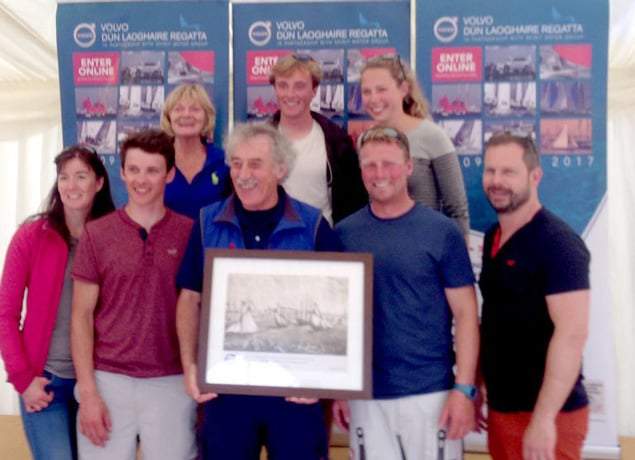 A satisfying sense of completeness. Alistair Rumball (centre) with the special Bicentenary Prize and the Irish National Sailing School crew of Jedi who won it
A satisfying sense of completeness. Alistair Rumball (centre) with the special Bicentenary Prize and the Irish National Sailing School crew of Jedi who won it
It was an image which encapsulated the key elements in the story of the harbour. In the long run, the problems with the shallow entrance to Dublin Port were overcome by dredging development, and the replacement of sailing ships by engine-powered vessels. But Dun Laoghaire remained of use to ships as it had been designated the official cross-channel Ferry Port in 1834, and until warship sizes outgrew it early in the 20th century, it was throughout the later 1800s a naval base, with the advantage of direct rail connection to the main naval base off Cobh in Cork Harbour.
However, although Dun Laoghaire Harbour was obliged to function within the size which had been decided for it in 1817, the increasing size of ships, together with the major changes in shore transport and acceptable road systems, increasingly restricted its potential as a commercial harbour and ferry port.
Then too, the attractive residential nature of Dun Laoghaire’s waterfront terraces of houses was once more in the ascendant. For a period, many had become offices, but with the commercial shipping aspects of harbour activity reducing, recent years have seen the reversion of the harbourside houses – many of them very handsome buildings indeed – to residential use.
 With berthing concentrated in the Marina, and the ferries gone, the close-fought fleet were able to enjoy Dun Laoghaire’s in-harbour finish. Photo David O’Brien/Afloat.ie
With berthing concentrated in the Marina, and the ferries gone, the close-fought fleet were able to enjoy Dun Laoghaire’s in-harbour finish. Photo David O’Brien/Afloat.ie
This has been particularly marked with the new property boom, but it was already under way when the last Holyhead ferry sailed in September 2014, and since then the fact that the Dun Laoghaire waterfront is no longer cluttered with ferry traffic has added to the area’s appeal as somewhere to live and enjoy the sea air and the views of recreational boating activity in the harbour. As for the background, we know that that recreational sailing use started at least as early at 1828, and continues today, busier than ever. But as for ferryport use, that didn’t begin until 1834, and it ended in 2014.
Admittedly the last relics of the ferry era are still much in evidence with the extensive shoreside marshalling yards at St Michael’s Pier and the former Ferry Terminal buildings still very much in existence. But as Dublin Port continues to develop its ferry and cruise liner berthing facilities at top speed, it is surely time for everyone in Dun Laoghaire to accept that their harbour’s future lies in another direction, a healthier direction for a place which is increasingly residential and recreational.
Whatever the outcome, the fact is that Dun Laoghaire Marina is now the main focal point of waterfront activity. In marina terms, it’s a distinctly grown-up sort of place. With its good depths and extensive berthing, it can confidently provide the RNLI with accessible-all-hours berthing for its reserve lifeboats – when Afloat.ie was visiting this week, there were two in port, ready for action at a moment’s notice. And during the winter, naval, coastguard and customs vessels know they can rely on its spaciousness and total shelter when required.
Thanks to its scale, it can cope with big boats and big events too. When Sidney Gavignet and his crew on the MOD 70 Oman Sailing were poised for a challenge at the Round Ireland Record in May 2016, they knew that they could base themselves in Dun Laoghaire marina without being under undue attention while they waited for the ideal conditions to materialise for what was a successful challenge.
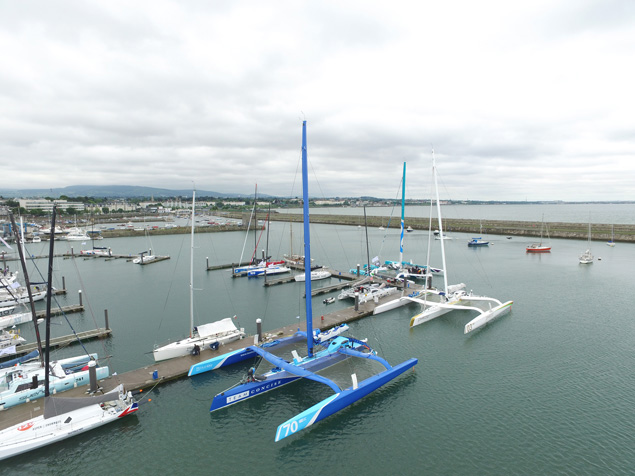 The three MOD 70s in Dun Laoghaire Marina before the Volvo Round Ireland Race in June 2016. Between them, they broke the Round Ireland Record three times in the summer of 2016.
The three MOD 70s in Dun Laoghaire Marina before the Volvo Round Ireland Race in June 2016. Between them, they broke the Round Ireland Record three times in the summer of 2016.
Yet when publicity was sought, as it was for the big boats in the Volvo Round Ireland Race in June 2016, the ideal setting was at the Royal Irish Yacht Club within the shelter of the marina when, despite inclement weather, there was an extraordinary gathering of
legendary race boats and sailing rock stars, all in one place at a berth which would have been untenable had it not been for Dun Laoghaire Marina’s sheltering arms.
So the contribution of the Marina to Dun Laoghaire’s rising status in international sailing deserves to be more widely recognised, as does the Marina’s significant contribution to many aspects of the local economy. But in making themselves and what they do more accessible to the general public, Paal Janson and his long-serving team are walking a tightrope, as they have to ensure urban-centre levels of security for the boats permanently berthed in their facility.
Glamour visitors may come and go, but the longterm berth-holders underpin the entire operation, and their needs are equally important. So perhaps it would be better to acknowledge he success Dun Laoghaire Marina achieves in what it sets out to do, and focus again on one up-coming event in particular. That is the start of the 2017 Rolex Fastnet Race on Sunday August 6th.
 Desert Star from Irish Offshore Sailing in Dun Laoghaire Marina rounding the rock in the Rolex Fastnet Race 2015, on her way to winning the Sailing Schools class of 33 boats…………..
Desert Star from Irish Offshore Sailing in Dun Laoghaire Marina rounding the rock in the Rolex Fastnet Race 2015, on her way to winning the Sailing Schools class of 33 boats………….. …..which was very pleasing indeed for the Marina General Manager back home. Photo: David O’Brien/Afloat.ie
…..which was very pleasing indeed for the Marina General Manager back home. Photo: David O’Brien/Afloat.ie
Of eleven entries with Irish involvement, six will be boats based in Dun Laoghaire Marina. That is clear evidence of the punch packed by the affluence of the Dun Laoghaire/Rathdown region, and the enthusiasm now being generated within Dun Laoghaire harbour.
And of those six boats, two will be in the Sailing Schools Division - Irish Offshore Sailing’s Desert Star, and Irish National Sailing School’s Jedi. There must be few marinas in Europe, other than those around the Solent, which are sending forth two entries for the Sailing Schools’ prize in the Fastnet. Yet Dun Laoghaire Marina can do it with style, knowing that one of its boats was the overall winner last time round.
With 80–days to go to the 2017 Mini Transat Race, solo sailor Tom Dolan was in Dun Laoghaire at his club, the National Yacht Club, to coach some friends out in the bay in an evening of fresh winds.
Tom is catching up with family and friends in Ireland before returning to his Mini Transat preparations in France.
The County Meath man has had a full season so far so the trip home has been something of a welcome break.
In June, Dolan got on the podium in the Mini-Fastnet Race despite being fouled by a fishing net. That same month, he was in second in the 500 Mini-en-Mai Race. In May, he finished second in the 500 Mini-en-Mai Race but was leading for a lot of it. And in a much needed development that month, Dolan also signed Smurfit Kappa as a sponsor.
Last night, NYC Commodore Ronan Beirne saluted all those solo achievements and presented club burgee to Dolan for his race across the Atlantic in October, in the 40th edition of the Mini–Transat race.
Last Sunday was a perfect sailing day – sun, wind, and lots of smiles as we celebrated 50 years of the Junior Sailing Section at the NYC. Commodore Ronan Beirne welcomed the families as they arrived in the Club. A mix of cruisers and club boats made up the flotilla that headed for Dalkey island for a morning sail.
Unfortunately, the Pontoon 50 Splash where the Juniors intended to create a new Guinness World Record to recognise the 50th year of Juniors in the NYC had to be postponed due to a swimming ban put in place by Dun Laoghaire Rathdown County Council, following an e.coli outbreak!
After a delicious BBQ back on land, the kids were challenged to an Egg Drop - this entailed an egg being dropped from the crane onto the pontoon, the winners being those who’s eggs remained intact. One or two bright sparks headed for the kitchen to have their eggs hard boiled, but there was plenty only fit for scrambling! Parachutes seemed to have been the most successful way to deliver the egg safely to the pontoon.
All the kids got a wonderful t-shirt specially produced for the day, which recognised the Juniors 50th Anniversary. The design of the t-shirt was the result of a competition amongst the kids a number of weeks prior to the event.
A Teddy’s ice cream van arrived onto the Platform and very quickly a queue of kids and adults swarmed around, with orders galore for 99s.
To round off the afternoon, a coach arrived to take the kids into town for the Viking Splash Tour. Another successful NYC day. Many helped, lots participated, importantly we had smiles all round.
Cotton Topsails Hoisted as National Yacht Club Welcomes Classic Boat Fleet for Kingstown 200 Cup
It could be over 50 years since a cotton topsail has been seen from the National Yacht Club and this afternoon as the classic fleet arrived "Peggy Bawn", a GL Watson 36–ft Cutter, built in 1894, hoisted her cotton suit of topsail and gaff main.
A temporary pontoon as been anchored off the Carlisle Pier and here the renovated Dublin Bay 24 footer "Periwinkle" this afternoon having sailed from France via the Scilly's and Greystones where some former 24 hands with long association with the class shipped on board, Chris Johnson, David Espey, Chris Craig and Terry Johnson.
On the National Yacht Club platform the Dublin Bay Mermaids were arriving by road and a fleet of "Fifes" from Royal Anglesey Yacht Club were being masted and launched having arrived by ferry.
The fleets arrival for the opening of the Volvo Dun Laoghaire Regatta and the inclusion of the classics for this edition will provide a historic spectacle from the East Pier.
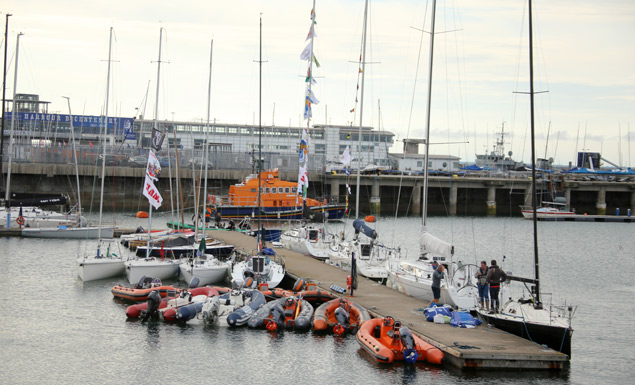 Dun Laoghaire Regatta entries line up at the National yacht club pontoon ahead of tomorrow's regatta
Dun Laoghaire Regatta entries line up at the National yacht club pontoon ahead of tomorrow's regatta
John D “Cas” Smullen 1930-2017
With his death at the age of 87, the loss of Cas Smullen deprives Irish sailing of a total enthusiast whose dedication to our sport was central to his entire existence. Such was his exuberant enjoyment of sailing that one of his many skippers remarked that, if your own delight in sailing was wilting in any way, you only had to spend a few days afloat in Cas’s company to find the flame of your personal enthusiasm being re-kindled with full vigour.
While his last ten years were restricted by illness and the ongoing effects of a stroke in 2007, his brain was sharp to the end, and he continued to enjoy convivial visits to his beloved National Yacht Club in Dun Laoghaire, where his membership was a record-breaking 71 years.
Although he wasn’t from a sailing family, in his youth he attracted the sailing community’s attention through his prowess as a swimmer, both in the harbour and as a star at Blackrock Baths, where he was a regular and stylish performer off the top diving board. Skippers looking for able-bodied young men for crewing duties in the Dun Laoghaire fleet rightly reckoned that young Smullen might have what it takes, and by the time he was 16, he was an active regular in a sport which fitted him like a glove.
So popular was he as a crew - and often in effect the skipper - that in his long sailing career, he never personally owned a boat. The nearest he came to it was when he built a Mirror dinghy for his son Johnny, who has since gone on to become the California-based classic yacht-builder to America’s Cup legend Dennis Conner, so the effects of that one experience have carried further than anyone could have imagined.
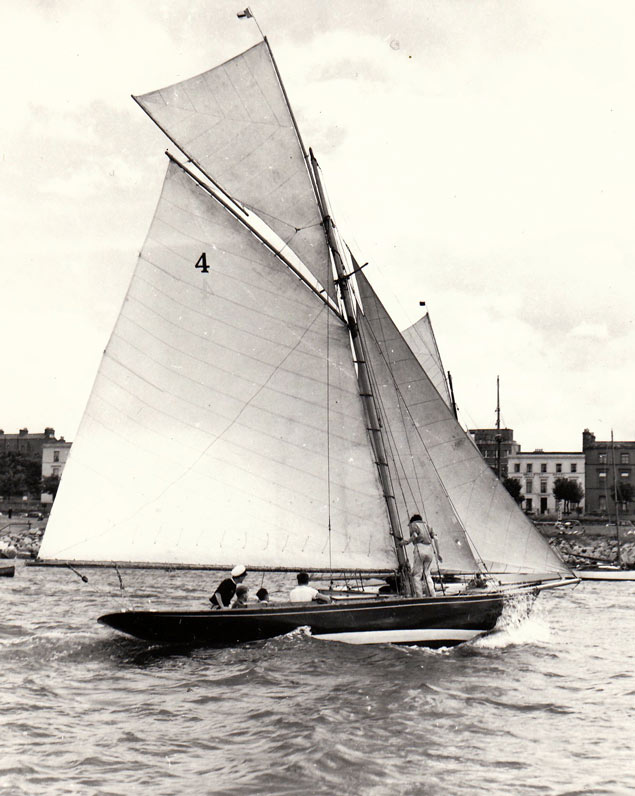 A Dublin Bay 21 in all her gaff-rigged finery. The class was contemplating changing to Bermudan rig in 1963 “to save time”, but Cas Smullen reckoned he could rig one single-handed in less than 15 minutes. The class challenged him to put on a display at the National YC, while they watched. He did it in nine minutes.
A Dublin Bay 21 in all her gaff-rigged finery. The class was contemplating changing to Bermudan rig in 1963 “to save time”, but Cas Smullen reckoned he could rig one single-handed in less than 15 minutes. The class challenged him to put on a display at the National YC, while they watched. He did it in nine minutes.
Cas Smullen was the quintessential Dublin Bay yachtsman, as his entire working life was spent as an insurance broker. This gave his day-to-day life a regularity which is unknown to many in today’s more restless working environment. For weeks on end – if he wasn’t away cruising or on some offshore racing campaign – he would invariably be racing without fail in the Dublin Bay SC fleet every Thursday evening, and again every Saturday afternoon.
It would take a substantial book to record all his cruises, as he became a member of the Irish Cruising Club in 1961. As for offshore racing, as a longtime member of the Royal Ocean Racing Club, he was fully into it at every level including sailing as a member of the Irish Admiral’s Cup team in 1969. But even with all those experiences, it was Dublin Bay sailing which was at the core of his sailing way of life, and he was a particular devotee of the Dublin Bay 21 Class, and then of the Dublin Bay 24 Class, especially noted for his skill in getting the best out of boats when racing in light airs.
He was in the heart of the Dublin Bay 21s in 1962-63 when the owners debated changing them from their demanding jackyard topsail-setting cutter gaff rig to a more easily-handled Bermudan sloop. On hearing that one of the reasons they wanted to change was that the boats could be more quickly rigged for racing, he claimed that this was nonsense. He said it didn’t take more than 15 minutes to rig them single-handed, and he would show them how, just to prove it.
The story has come down the ages that one of the Dublin Bay 21s was brought in close to the National YC with all sails harbour-stowed, and an audience gathered on the balcony, drinks in hand, to watch Cas Smullen rig the boat in a quarter of an hour. The word was that he achieved it with style, but they went ahead and changed to Bermuda rig anyway.
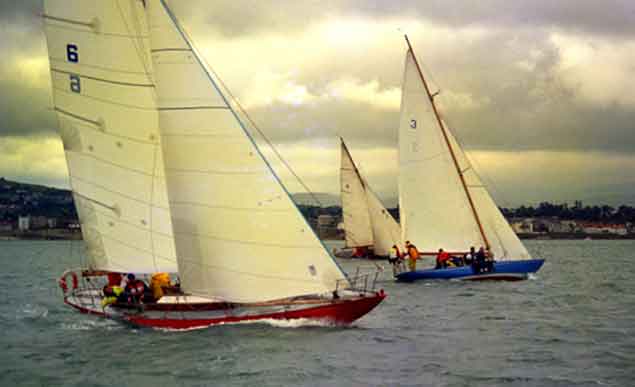 The Johnston family’s Dublin Bay 24 Harmony racing in the Dublin Bay Woodenboat Regatta of 1997 with Cas Smullen on board. Photo: W M Nixon
The Johnston family’s Dublin Bay 24 Harmony racing in the Dublin Bay Woodenboat Regatta of 1997 with Cas Smullen on board. Photo: W M Nixon
We recounted that story again recently on Afloat.ie, and his daughter Jean – the nationally-known wine expert – took her laptop into the hospital to read it to him. He much enjoyed it, but with eyes sparkling despite his infirmity, he firmly insisted on one correction. It was actually all done in nine minutes - not fifteen. We are more than happy to take this opportunity to put the record straight on that point in the definitive Cas Smullen story. In extending our heartfelt condolences to his family in their loss of this unique, great and much-loved character, it is in the knowledge that the world of Irish sailing has been a better and more interesting place for having had Cas Smullen in the heart of it.
WMN
'Vigorous' Start to Dun Laoghaire to Dingle Dash
If anyone is thinking of producing the Very Rough Guide to Making a Start in a Yacht Race, this evening’s opening episode in the continuing drama which is the 275-mile Volvo Dun Laoghaire to Dingle Race 2017 produced Rules 1, 2 & 3 in jig time writes W M Nixon
Rule 1 states: “When push comes to shove, might is right.”
Rule 2 states: “When you’re in the bigger boat, never give an inch until you actually hear breaking glass”
Rule 3 states: “Whatever happens, keep smiling as though it’s all perfectly normal.”
It was of course entirely the weather’s fault. An expected veering of the southerly wind, forecast for the start time around 1900 hours, actually arrived a clear hour early. Thus, where it should have been a beat from the start line in Scotsman’s Bay to the first mark of the course at the Muglins, it was the closest of close fetches on starboard tack.
And though Race Officer Con Murphy then put a marked bias on the line to encourage people not to crowd in on the Committee Boat, the testosterone-fuelled racers setting up to get to Kerry just as fast and as soon as they could crowded towards the Committee Boat like crazed bees around a honey pot.
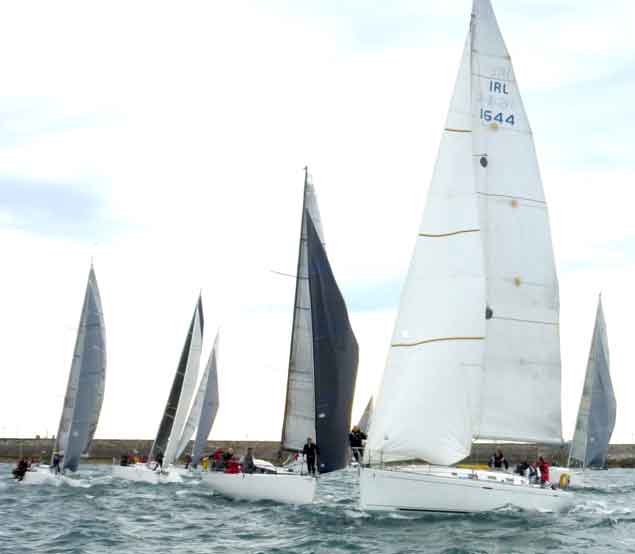 Animal spirits rampant. Still about 35 seconds to go to the start, but those boats (left) are coming in far too fast with no-one easing up.........Photo: W M Nixon
Animal spirits rampant. Still about 35 seconds to go to the start, but those boats (left) are coming in far too fast with no-one easing up.........Photo: W M Nixon ....as seen from the pin end...Photo: Afloat.ie
....as seen from the pin end...Photo: Afloat.ie
 Soon the madness spreads and everyone is going for the line......Photo: W M Nixon
Soon the madness spreads and everyone is going for the line......Photo: W M Nixon .......and this is the scene with five seconds still to go to the start. Photo: W M Nixon
.......and this is the scene with five seconds still to go to the start. Photo: W M Nixon
 And they're off.....National Yacht Club Commodore Ronan Beirne spots the line from the NYC pin end RIB. Eamonn Crosbie's Pamela, IRL 5503, the largest yacht in the Dingle Race, makes a great start at the leeward end Photo: Afloat.ie Or at least that’s how it seemed from the Committee Boat itself. In a fleet of 43 boats, there were of course plenty of reasonable souls making civilized starts further down the line. But it was such a close fetch to shape your course right on the Muglins that the hottest competition couldn’t resist the temptation to take every bit of weathering that they could at the start.
And they're off.....National Yacht Club Commodore Ronan Beirne spots the line from the NYC pin end RIB. Eamonn Crosbie's Pamela, IRL 5503, the largest yacht in the Dingle Race, makes a great start at the leeward end Photo: Afloat.ie Or at least that’s how it seemed from the Committee Boat itself. In a fleet of 43 boats, there were of course plenty of reasonable souls making civilized starts further down the line. But it was such a close fetch to shape your course right on the Muglins that the hottest competition couldn’t resist the temptation to take every bit of weathering that they could at the start.
The result was that a herd of marauding bulls came charging in, but they were going to be about ten seconds early, yet nobody seemed to be able to do a damn thing about it until a certain 44–footer realized the only option was to bear off and sail down the line as though this was normal procedure. Most of the fleet being smaller craft, those in the immediate vicinity gave way, albeit with wailing and gnashing of teeth.
Out of one sailor’s adversity comes another’s advantage, and though Stephen Quinn and Dave Cotter in the sweet little J/97 Lambay Rules, racing in the Two-handed Division, were all in order to make a proper and perfect start, some other bigger fully-crewed machine rolled over them and down across their bows, stitching up Lambay Rules good and proper.
But the canny old salts on Ian Hickey’s veteran Granada 38 Cavatina sensed that a gap was going to appear out of nowhere, Lambay Rules’ undoing was their advantage, and they swept through the gap to make the best start in the fleet.
As that seasoned observer of Dublin Bay sailing Ian Meldon drily remarked: “That was a vigorous start”. And with a beat in prospect from the Muglins at least to the Fastnet Rock, the kerfuffles of the start were soon put astern and people settled down to serious racing.
 Early leader – George Sisk's Wow, a Farr 42, lead the fleet out of Dublin Bay Photo: Afloat.ie
Early leader – George Sisk's Wow, a Farr 42, lead the fleet out of Dublin Bay Photo: Afloat.ie
Once the Muglins were passed, some boats made the curious decision to continue on starboard tack on out into the strongest line of the new north-going flood. But with further veering of the wind expected, it was Paul O’Higgins JPK10.80 Rockabill VI which first took the seemingly logical decision to tack inshore, with Derek Martin’s First 44.7 Lively Lady and George Sisk’s Farr 42 WOW going with her.
 The Spirit 54 Soufriere (Stephen O'Flaherty) leads a group of boats passed the Muglins with Mojito (Peter Dunlop & Vicky Cox), Cavatina (Ian Hickey) and Lambay Rules (Stephen Quinn) all leaving Dublin Bay together Photo: Afloat.ie
The Spirit 54 Soufriere (Stephen O'Flaherty) leads a group of boats passed the Muglins with Mojito (Peter Dunlop & Vicky Cox), Cavatina (Ian Hickey) and Lambay Rules (Stephen Quinn) all leaving Dublin Bay together Photo: Afloat.ie
Yet the more you hug the shore, the flukier the winds might be. And as midnight nears, the leaders are in the tricky situation of approaching the hyper-strong foul tide in the vicinity of Wicklow Head. But WOW has been sailing a blinder, skilfully staying sufficiently clear enough of Bray Head to avoid its notorious flat spots, yet working the land from Greystones southward to such good effect that she leads on corrected time with Lively Lady second, Andrew Algeo’s Juggerknot the best of the J/109s in third, and Rockabill VI fourth.
Athough two larger J Boats didn’t make the start, we’ve even more J/109s than were officially listed. For although he and all his crew knew that of course Stephen Tudor and the 2016 ISORA Champion Sgrech knew they were doing the Dingle race, it seems they omitted to tell the organisers. But they’re in there anyway, battling as usual with sister-ship and clubmate Mojito (Peter Dunlop & Vicky Cox).
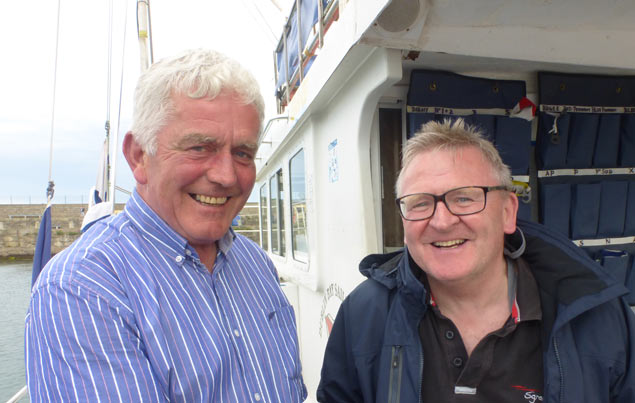 “But surely you just knew we’d be racing to Dingle?” Very late entrant Stephen Tudor (right) with Ian Meldon of the National YC Photo: W M Nixon
“But surely you just knew we’d be racing to Dingle?” Very late entrant Stephen Tudor (right) with Ian Meldon of the National YC Photo: W M Nixon
Race tracker here
Even with leading contenders Aurelia (J/122) and Jacana (J/115) scratching (the former with rigging problems, the latter with logistics difficulties), J/Boats still might have it all the way in the remaining fleet of 43 boats in the National YC’s 275-mile Volvo Dun Laoghaire-Dingle Race, which starts this evening off the East Pier at 1900hrs writes W M Nixon.
After all, in 2015 it was J/Boats filling most of the top six places, with the J/109 Ruth (Shanahan family) taking it by twenty minutes from sister ship Mojito (Peter Dunlop & Vicky Cox). So far in the 2017 season, Mojito has been the Irish Sea pace-setter, so she has to be seen as the smart money bet.
Against that, Paul O’Higgins’ JPK 10.80 Rockabill VI is safely back in her home port of Dun Laoghaire after a fast incident-free passage returning from the ICRA Nats in Crosshaven, where she’d showed steadily improving performance. We have to remember that she was overall winner of ISORA’s first all-feet cross-channel race last month, so never under-estimate a JPK 10.80 – they specialise in surprises.
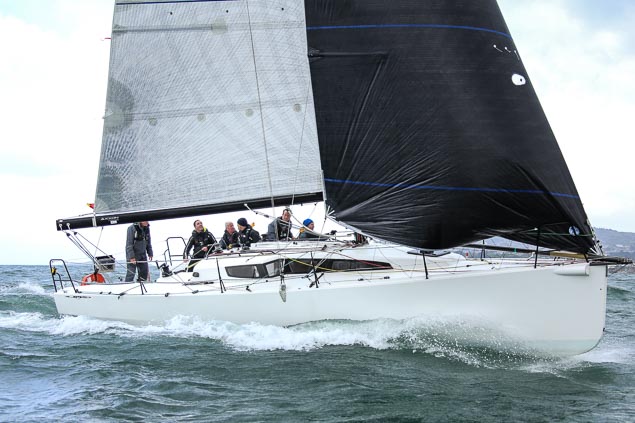 Rockabill VI – the JPK 10.80 is a recent ISORA cross channel winner. Photo: Afloat.ie
Rockabill VI – the JPK 10.80 is a recent ISORA cross channel winner. Photo: Afloat.ie
The J/Boat dominance continues into the 11-strong Two-Handed Division, where defending champions Colm Buckley and Simon Knowles have upped their game from the Elan 340 Blue Eyes to the J/109 Indian. They won the ISORA Dun Laoghaire-Arklow Race in Indian fully crewed, so they have good form, but ironically their closest competition may come from Howth clubmates Stephen Quinn and Dave Cotter racing the significantly smaller J/97 Lambay Rules, which has been one of Irish offshore racing’s most consistently successful performers at home and abroad for a couple of seasons.
Inevitably, though, with the wind veering steadily during the course of the race, the fastest front runners will be favoured, as they may find they get to crucial headlands while it is still just possible to lay the course direct to the next headland, whereas it looks as though the little ’uns will be slugging it out to windward just about every inch of the way.
And there’s no doubt that “slugging” will be the operative word. Writing this at noon on Wednesday, the wind is still moderate to fresh southerly in the Irish Sea, while the Dublin Bay effect means there’s a strong touch of east in the breeze off Dun Laoghaire to make for a distinctly rumbly sea.
But just at start time, a veering is forecast with an untable gusty front coming through to switch the underlying wind to sou’sou’west. While this may see the average wind speed at a manageable 15 mph, it will make for harder work for crews, as the gusts will see the top strengths rocket up to 25 and even 30-32 mph.
On top of that, the ebb tide will be running south for no more than a couple of hours after the start, and much less at some locations. So it could well be that some crews will get to know what an accursed place Bray Head can be when the unstable wind is beginning to acquire an offshore element, and you’re trying to get inshore and best-placed to deal with a foul tide.
And all that within hours of the start. It has all the makings of quite a rugged race, and those who make the already legendary Prize Giving Party in Benner’s Hotel on Saturday night in the heart of Dingle will have certainly earned it.
By that time, however, better weather will have settled in, and the challenging conditions of Wednesday night and Thursday will be fading behind memories of finishing in summery conditions.
Race tracker here
A 43–boat fleet are expecting an upwind start and winds gusting to 25–knots for tonight's 7pm Dun Laoghaire–Dingle Race at the National Yacht Club.
At start time, winds are expected to shift from a southerly to a south westerly direction and increase in what looks like an unstable front. Gusts are expected up to 30–knots tonight on the east coast. Winds are expected to go westerly tomorrow for the 275–mile race to County Kerry.
 XC weather's forecast for tonight's D2D race from Dun Laoghaire
XC weather's forecast for tonight's D2D race from Dun Laoghaire
The record entry fleet of 45 is down by two boats that have withdrawn. Royal St. George's J122 Aurelia, a top ISORA performer, has pulled out due to rig problems and another J-boat, the Carrickfergus–based J133 Spirit of Jacana was delayed in getting to Dun Laoghaire due to weather.
 Rig problems have forced Chris Power–Smith's J122 Aurelia out of the race
Rig problems have forced Chris Power–Smith's J122 Aurelia out of the race
At the National Yacht Club HQ, the Royal Ocean Racing Club has given input into race Sailing Instructions with a view to standardising documentation prior to the Dun Laoghaire–Dingle Race's incorporation into the RORC calendar for 2019.
The RORC's Janet Grosvenor and Commodore Michael Boyd (the weekend winner of the RORC's Morgan Cup race) will be in Dun Laoghaire to observe tonight's departure.
Read the full race preview by WM Nixon here.
Read also:
Dun Laoghaire to Dingle Race Tracker
Dun Laoghaire Dingle Race Form Guide: D2D Could Be Another J/Boats Triumph
Five Reasons Why Volvo 'D2D' is The Perfect Mini-Offshore Race
Dun Laoghaire Dingle Race Entry 'Exceeds all Expectations'
Dun Laoghaire to Dingle Yacht Race Gets National Yacht Club Turbo Power
WM Nixon will be posting regular race updates on Afloat.ie here


























